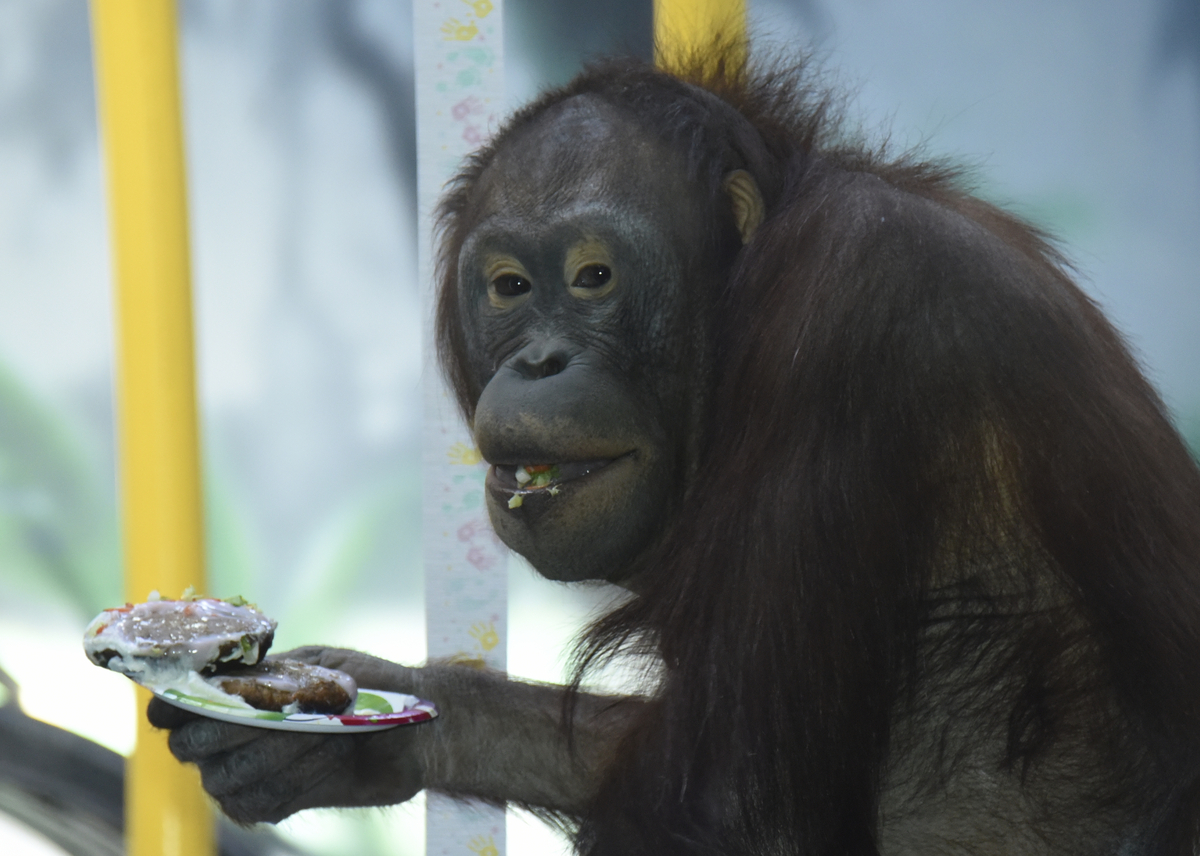Zoo’s mother-to-be receives prenatal care from UW-affiliated health professionals

Kawan, a Bornean orangutan at the Henry Vilas Zoo in Madison, is being cared for during her pregnancy by UW health professionals.
Photo courtesy of Henry Vilas Zoo
While many in Madison were surprised and delighted on Feb. 10 to learn that Henry Vilas Zoo’s Bornean orangutan, Kawan, was expecting the zoo’s first baby primate in 14 years, it was old news to Barb Trampe, chief sonographer at the UW/Meriter Center for Perinatal Care. She had already seen the first baby pictures.
Trampe is part of a team that has monitored and cared for Kawan since late last summer. Every other week, Trampe goes to the zoo to record ultrasound images of Kawan’s baby, using an older machine donated by the Department of Obstetrics and Gynecology, which recently upgraded its technology.
Human OB-GYN Jenny Hackforth-Jones of Associated Physicians of Madison, who trained at the UW and maintains a volunteer adjunct teaching role with the School of Medicine and Public Health, was also brought in to help care for Kawan both before and during her pregnancy. An orangutan pregnancy closely mirrors a human pregnancy. Should Kawan experience any complications during pregnancy or birth, Hackforth-Jones will be there to assist the zoo’s staff.
“They want to merge the best expertise available from human medicine, veterinary medicine and animal behavior,” Trampe says.
Trampe spends much of her time working with UW perinatologists and teaching ultrasound techniques to UW medical students, residents and fellows.
But this isn’t her first stroll in the zoo. She worked with her father, a zookeeper in the 1950s and ’60s, during summers and breaks from school. She has performed thousands of ultrasounds on human moms, but orangutan ultrasonography is an entirely different animal.
Orangutans can often be uncertain of new people and objects in their environments, so Trampe’s relationship with Kawan and mate Datu began with weeks of conditioning, where she would simply spend time with them near their enclosure and give them a special treat when they were cooperative.
Eventually, Kawan became comfortable enough with Trampe’s presence — and that of the ultrasound machine — that she began to voluntarily present her abdomen at the edge of the enclosure, allowing herself to be touched with the transducer probe — the part of the ultrasound machine that comes in contact with the belly during imaging.
Kawan dislikes ultrasound gel, which allows the sound to penetrate better and create a clearer picture. So Trampe uses plain water instead.
While human women recline on an exam table during an ultrasound, Kawan stands upright. The orangutan’s personality, which Trampe described as “very sweet, but a little bit shy and moody,” can also be challenging. If Kawan decides she isn’t in the mood, there’s no ultrasound that day.
On the best of days, Trampe has just a few minutes to record the necessary images. When Kawan moves away from the machine, the exam is over.
“We’ve been able to get a heart rate each time, and we’ve seen the placenta, outlines of some organs, and we can see that the head is down,” Trampe says. “We haven’t seen enough detail to take measurements, or to identify sex.”
Both Trampe and Hackforth-Jones say the orangutans, who are very humanlike and have the intelligence of an average five- or six-year-old human child, have been a pleasure to work with. Both expressed gratitude for the experience and investment in the success of Kawan’s pregnancy.
“I feel like a grandmother to be,” Hackforth-Jones says.
“I think the thing that is joyful about working with pregnant women and families is that you get to enjoy and excite in their pregnancies with them,” Trampe added. “With Kawan, we’re having the same joys and excitement but we don’t know how much she understands. She doesn’t understand that she’s having an ultrasound and that we’re looking at her pregnancy. So we are all experiencing the family joy on her behalf.”
– Nicholas Brigham Schmuhl
Tags: health & medicine



